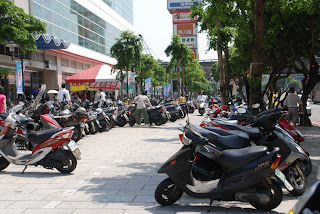The port
town of Danshui lies north of Taipei, where the Danshui River meets the
ocean. The name is usually pronounced
Dan-Shway, however it is spelled in Pinyin English many different ways,
including Danshui, Tamsui, Danshuei and others.
Taiwanese Chinese can be confusing.
The city was settled by the Spanish in the early seventeenth century and
was more important than Taipei for several hundred years. The Taipei MRT system runs the entire way to
Danshui and due to the transportation ease; it is a popular weekend travel
location for the people of Taipei.
The red
brick Fort San Domingo was constructed by the Spanish in 1629 and later
occupied by the Dutch, Chinese and British.
It was the British consulate until 1980.
Scottish Canadian missionary George Mackay was highly respected for his
work in the 19th century. He
constructed hospitals, churches and universities around Taiwan and spent much
of his time in Danshui or Tamsui, whatever the city is called. The red brick Aletheia University, also
called Oxford, is now a museum dedicated to Mackay’s work. A bust of Mackay is featured in the town center.
Fisherman
use the port to access the Straits of Taiwan and Pacific Ocean. As you can see by the picture, it is
important to plan your fishing excursion based on the tides. There is some commercial port activity
nearby.
As in any
Taiwan city, the street foods are fantastic.
We ate little quail eggs, deep fried animal body parts and the most
wonderful ice cream dish I have ever tasted.
A thin rice “tortilla” is filled with ground peanuts, cilantro and ice
cream, and then rolled like a burrito and it becomes a nice handheld treat.
Our day trip to Danshuei or Tamsui or whatever the city is called was one of many discoveries that my wonderful wife has made possible.






























